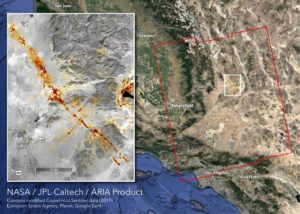ShakeAlertLA Allows for Heightened Earthquake Response
During the first week of July, Southern California experienced two of its strongest earthquakes in recent years. While the quakes led to some structural damage to buildings and homes, there were no casualties and the two incidents provided a unique opportunity to test the cities new earthquake alert app, known as ShakeAlertLA. A collaborative program developed through a partnership between the Office of Los Angeles, Mayor Eric Garcetti, and the U.S. Geological Survey (USGS), ShakeAlertLA alerts those in the Los Angeles county if an earthquake of at least a 5.0 magnitude on the Richter scale, or one that will produce “light” shaking in Los Angeles, is detected. The app is an example of technology that will strengthen the LA regions’ response to natural disasters and allow them to become more resilient in the face of future strong earthquakes. Even though they were the most severe quakes in decades, two recent quakes still did not produce enough shaking to trigger the alert system, as they were both below a magnitude of 4.5. Because of this, the app’s performance concerned some users who felt it did not satisfy their expectations.

In order to generate an alert, USGS seismic sensors along the West Coast first detect the initial shaking. Using cellular and radio technology, the data generated by the shaking is sent to a processing center, where an algorithm has been generated by ShakeAlert to interpret whether or not the shaking warrants an alert be sent out to users. For the recent California earthquakes, an alert was created just 6.9 seconds after the initial detection, however the magnitude of the quakes was not enough for the alert to be sent out to public users of the app. USGS has said that future warnings could go out in even shorter amounts of time. Los Angeles is the first U.S. city to make the app available to the public, and it has already been downloaded by more than 500,000 people.
Warning systems like ShakeAlert are essential in aiding regions that are threatened by the effects of earthquakes. FEMA has estimated that 61% of the nationwide average annual loss from earthquakes will come from California, amounting to $3.7 billion. Additionally, California has a 99.7% chance of experiencing a magnitude 6.7 or larger earthquake in the next 30 years. ShakeAlert can be used to minimize the damage from these future events. In the amount of time between receiving an alert and feeling the effects of an earthquake, trains can be slowed down and cars can be prevented from entering bridges or tunnels. Industrial systems can be shut off and dangerous machines or chemicals can be secured with enough time for individuals to move a safe distance away. When people are given even a small amount of advanced warning for an earthquake, they will be able to seek some form of shelter and respond more effectively. These efforts will reduce damage and casualties during an earthquake and prevent worsened destruction in the aftermath.
Similar systems to ShakeAlert have already proven successful. In Japan, the Early Earthquake Warning system has used a variety of technologies to build resilience throughout the country. During the 2011 9.1 magnitude Tohoku quake, the system automatically signaled high-speed trains to slow down, preventing any derailments. Alerts were sent through the national broadcaster NHK 90 seconds before buildings began to shake, and cell phone warnings allowed students to find shelter under their desks. Yurekuru, a smartphone app made in partner with the Early Earthquake Warning system, allows residents to customize their alerts and decide the amount of shaking that must occur before they receive a warning.
Moving forward, ShakeAlertLA officials plan to modify the app to ensure its effectiveness. In response to public backlash due to the lack of an alert during the most recent quakes, the app will now send alerts for earthquakes of at least a 4.5 magnitude or “weak” shaking capabilities. Continued expansion of the warning system and public adjustment to the app will help the region brace for future disasters and minimize the damage felt.
Sources and Further Reading
L.A.’s ShakeAlert earthquake warning app worked exactly as planned. That’s the problem – Los Angeles Times
Download the ShakeAlertLA Earthquake Early Warning App Now – City of Los Angeles
ShakeAlert: An Earthquake Early Warning System for the West Coast of the United States – ShakeAlert.org
Los Angeles’ ShakeAlert app did not send an early warning about the California quake – again – CNN
